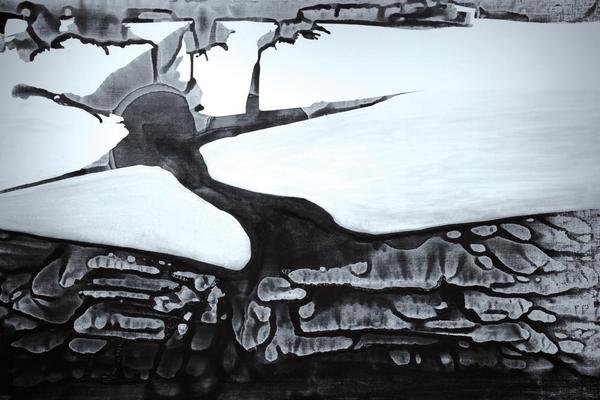Gao Xingjian
dal 4/12/2008 al 29/4/2009
Segnalato da
4/12/2008
Gao Xingjian
Museo Wurth, La Rioja
After the Deluge

“Art is a refuge where our spirit can fly.”
G.X.
The aesthetic, poetic sensitivity of the new artist in the Würth Collection Spain, Gao Xingjian, is the main feature of the third exhibition of the
Museo Würth La Rioja in which, thanks to the works on loan from the artist, we have 80 pieces on display which offer us a complex vision of Gao’s
artistic expression.
Although Gao Xingjian is well-known for having received the Nobel Prize for Literature in the year 2000, his long, versatile professional career reveals
him to be a novelist, playwright and essayist, as well as film and stage director, as well as an artist of great international renown. Literature and
painting encounter serene complicity in the figure of the artist, in which the one is the inseparable complement to the other, one is an extension of
the other: “I paint when I am tired of on writing. I write when I am tired of painting”.
Gao Xingjian was born in 1940 in Ganzhou, in China’s eastern Jiangxi province. He studied French and worked as a translator and later as a scriptwri-
ter at the Theatre of Popular Art in Peking. In 1978 he travelled to France and Italy for the first time as interpreter for a group of Chinese writers and
had the chance to deepen his knowledge of contemporary western art thanks to his visits to the great European museums. This led him to reflect on
the expressive possibilities of traditional Chinese painting and helped him to make the decision to develop this painting technique. At the same time,
he began to make a name for himself as a dramatist, but the première of his play, Bus Stop (1983) brought the censors down on him and limited his
creative freedom. In 1987, at the invitation of various French and German institutions, he abandoned China and settled in Paris. Two years’ later, due
to the events of Tiananmen square, he wrote his stage play The Flight which was met by a total ban on the performance of all his plays in China
and his being declared persona non grata, as well as the granting of political refugee status by the French Republic. Since then, he has distinguis-
hed himself as an artist and playwright, with exhibitions and performances of his works in some of the most important artistic spaces in the world
(such as the Museo Nacional Centro de Arte Reina Sofía, Madrid), and his work forms part of such major art collections as the Nobel Foundation, the
Stockholm Museum of Modern Art or the Taipei Art Museum in Taiwan.
Gao’s paintings are in Chinese ink, sometimes on small sheets of rice paper, sometimes on large format canvases. The gouache technique, which
comes from the traditional Chinese technique of xieyi (literally “painting of the feelings” or “writing of the spirit”), allows him to create subtle,
intuitive settings and characters who move in the limits between figurative and abstract art. At the same time, Gao brings his knowledge of western
art to the Chinese tradition and introduces depth in his works, as well as investigating subject matter in his paintings. Gao uses Chinese ink with
light, fluent strokes, full of contrasts which explore the expressive possibilities of black, creating nuances, light, chiaroscuros, textures and volumes
which spring from the artist’s own introspection. Gao paints from the emotions and his forms suggest sensations (Search, Nostalgia, Illusion) subtle
natural phenomena (Momentary Rain, The Mist) or the artist’s vision of the presence (Alienation, The End of the World, The Flight).
After the Deluge, in the Museo Würth La Rioja, shows works by
Gao Xingjian dating from the early 80s to date and is organised
around the technique (Chinese ink on rice paper or Chinese ink
on canvas) and, particularly, around topics. The subtle differece
between abstraction and the representation of the figurative
modulates the exhibition, and the reflections on feelings articulate
the spaces.
In the words of the expert on contemporary art Montse Badía,
“all Gao’s works respond to a unique vision: that of man’s destiny,
the essence of human existence”; in the words of the artist
himself “we can flee political tyranny, but we can never flee from
ourselves”.
Image: Lightning, 2006, Ink on canvas, 200 x 300 cm
Press contact:
David Monfort
Marbet Servicios Creativos
Pol. Ind. Riera de Caldes Calle Joiers, 21 Barcelona tel +34 936 033258 fax +34 936 643143 david.monfort@marbet.es
Museo Würth La Rioja
Avda. Los Cameros pcls. 86, 87 and 88 26150 Agoncillo-La Rioja
Hours:
Monday-Saturday: 10:00-20:00h
Sundays: 10:00-15:00h



